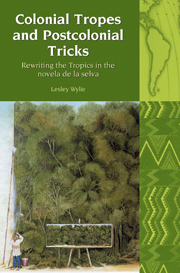Book contents
- Frontmatter
- Contents
- Acknowledgements
- Introduction
- 1 Colonial Tropes and Postcolonial Tricks
- 2 Tropical Nature and Landscape Aesthetics
- 3 Salvaging the Savage
- 4 Paradise Lost: Wilderness and the Limits of Western Escapism
- 5 Jungle Fever: Degeneration as a Trop[olog]ical Disease
- Conclusion
- Bibliography
- Index
Introduction
- Frontmatter
- Contents
- Acknowledgements
- Introduction
- 1 Colonial Tropes and Postcolonial Tricks
- 2 Tropical Nature and Landscape Aesthetics
- 3 Salvaging the Savage
- 4 Paradise Lost: Wilderness and the Limits of Western Escapism
- 5 Jungle Fever: Degeneration as a Trop[olog]ical Disease
- Conclusion
- Bibliography
- Index
Summary
In Keywords Raymond Williams observed that ‘nature’ and ‘nation’ derive from the same Latin root, nasci, ‘to be born’. In the context of Spanish-American literature the coincidence between nature and the nation transcends merely a shared etymology. Throughout the founding fictions of the nineteenth and early twentieth centuries Spanish-American authors enshrined nature, especially the tropical rainforest, as a source of literary identity. While prior to independence South America's landscape and people had largely been represented by outsiders, the novela de la selva – the Spanish-American Jungle Novel – turned to the rainforest, and the indigenous communities who lived there, in order to construct a distinctively American literature. Through parodic reworkings of European perceptions of the tropics in literature and anthropology the novela de la selva transformed the burdensome texts of the colonial era into enabling stories of cultural and narrative self-determination, inaugurating a home-grown tradition of tropical nature writing, which resonates in Latin American literature to the present day.
The novela de la selva has often been viewed as a minor offshoot of the novela de la tierra, and has been discussed alongside classic novels of this genre such as Rómulo Gallegos's Doña Bárbara and Ricardo Güiraldes's Don Segundo Sombra, ignoring the environmental specificity of the genre. This book examines the novela de la selva in the context of writing about tropical South America, particularly the dense forests surrounding the Amazon and Orinoco Rivers.
- Type
- Chapter
- Information
- Colonial Tropes and Postcolonial TricksRewriting the Tropics in the novela de la selva, pp. 1 - 13Publisher: Liverpool University PressPrint publication year: 2009

